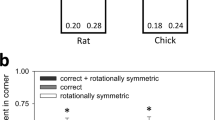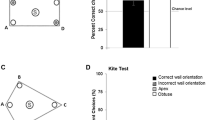Abstract
Non-human animals and human children can make use of the geometric shape of an environment for spatial reorientation and in some circumstances reliance on purely geometric information (metric properties of surfaces and sense) can overcome the use of local featural cues. Little is known as to whether the use of geometric information is in some way reliant on past experience or, as would likely be argued by advocates of the notion of a geometric module, it is innate. We tested the navigational abilities of newborn domestic chicks reared in either rectangular or circular cages. Chicks were trained in a rectangular-shaped enclosure with panels placed at the corners to provide salient featural cues. Rectangular-reared and circular-reared chicks proved equally able to learn the task. When tested after removal of the featural cues, both rectangular- and circular-reared chicks showed evidence that they had spontaneously encoded geometric information. Moreover, when trained in a rectangular-shaped enclosure without any featural cues, chicks reared in rectangular-, circular-, or c-shaped cages proved to be equally able to learn and perform the task using geometric information. These results suggest that effective use of geometric information for spatial reorientation does not require experience in environments with right angles and metrically distinct surfaces, thus supporting the hypothesis of a predisposed geometric module in the animal brain.







Similar content being viewed by others
References
Bingman VP, Erichsen JT, Anderson JD, Good MA, Pearce JM (2006) Spared feature-stricture discrimination but diminished salience of environmental geometry in hippocampal-lesioned homing pigeons (Columba livia). Behav Neurosci 120:835–841
Brown AA, Spetch ML, Hurd PL (2007) Growing in circles: rearing environment alter spatial navigation in fish. Psychol Sci (in press)
Cheng K (1986) A purely geometric module in the rat’s spatial representation. Cognition 23:149–178
Cheng K (2005) Reflections on geometry and navigation. Connect Sci 17:5–21
Cheng K, Gallistel CR (2005) Shape parameters explain data from spatial transformation: comment of Pearce et al. (2004) and Tommasi and Polli (2004). J Exp Psychol: Anim Behav Proc 31:254–259
Cheng K, Newcombe NS (2005) Is there a geometric module for spatial orientation? Squaring theory and evidence. Psychon Bull Rev 12:1–23
Chiandetti C, Regolin L, Sovrano VA, Vallortigara G (2007) Spatial reorientation: the effects of space size on the encoding of landmark and geometry information. Anim Cogn 10:159–168
Dehaene S, Izard V, Pica P, Spelke ES (2006) Core knowledge of geometry in an Amazonian indigene group. Science 311:381–384
Deipolyi A, Santos L, Hauser MD (2001) The role of landmarks in cotton-top tamarin spatial foraging: evidence for geometric and non-geometric features. Anim Cogn 4:99–108
Fodor JA (1983) The modularity of mind. MIT, Cambridge, MA
Gallistel CR (1990) The organization of learning. MIT, Cambridge, MA
Gouteux S, Thinus-Blanc C, Vauclair J (2001) Rhesus monkeys use geometric and non-geometric information during a reorientation task. J Exp Psychol Gen 130:505–519
Gray ER, Bloomfield LL, Ferrey A, Spetch ML, Sturdy CB (2005) Spatial encoding in mountain chickadees: features overshadow geometry. Biol Lett 1:314–317
Hermer L, Spelke ES (1994) A geometric process for spatial reorientation in young children. Nature 370:57–59
Hermer L, Spelke ES (1996) Modularity and development: the case of spatial reorientation. Cognition 61:195–232
Karmiloff-Smith A (1992) Beyond modularity: a developmental perspective. MIT, Cambridge
Kelly DM, Spetch ML, Heth CD (1998) Pigeons (Columba livia) encoding of geometric and featural properties of a spatial environment. J Comp Psychol 112:259–269
Learmonth AE, Nadel L, Newcombe NS (2002) Children’s use of landmarks: implication for modularity theory. Psychol Sci 13:337–341
Learmonth AE, Newcombe NS, Huttenlocher J (2001) Toddlers’ use of metric information and landmarks to reorient. J Exp Child Psych 80:225–244
Nadel L, Hupbach A (2006) Cross-species comparisons in development: the case of the spatial “module”. In: Johnson MH, Munakata Y (eds) Attention and performance XXI. Oxford University Press, Oxford
Newcombe NS, Sluzenski J, Huttenlocher J (2005) Pre-existing knowledge versus on-line learning: what do young infants really know about spatial location? Psychol Sci 16:222–227
Sokal RR, Rohlf FJ (1969) Biometry. The principles and practice of statistics in biological research. WH Freeman, San Francisco
Sovrano VA, Vallortigara G (2006) Dissecting the geometric module: a sense-linkage for metric and landmark information in animals’ spatial reorientation. Psychol Sci 17:616–621
Sovrano VA, Bisazza A, Vallortigara G (2002) Modularity and spatial reorientation in a simple mind: encoding of geometric and non-geometric properties of a spatial environment by fish. Cognition 85:B51–B59
Sovrano VA, Bisazza A, Vallortigara G (2003) Modularity as a fish views it: conjoining geometric and non-geometric information for spatial reorientation. J Exp Psych: Anim Behav Proc 29:199–210
Sovrano VA, Bisazza A, Vallortigara G (2005) Animals’ use of landmarks and metric information to reorient: effects of the size of the experimental space. Cognition 97:121–133
Sovrano VA, Bisazza A, Vallortigara G (2007) How fish do geometry in large and in small spaces. Anim Cogn 10:47–54
Spelke ES (2003) What makes us smart. Core knowledge and natural language. In: Gentler D, Goldin-Meadow S (eds) Language in mind. Advances in the study of language and thought. MIT, Cambridge, MA, pp 277–311
Tinbergen N (1951) The study of instinct. Oxford University Press, Oxford, UK
Tommasi L, Gagliardo A, Andrew RJ, Vallortigara G (2003) Separate processing mechanisms for encoding geometric and landmark information in the avian hippocampus. Eur J Neurosci 17:1695–1702
Vallortigara G (2004) Visual cognition and representation in birds and primates. In: Rogers LJ, Kaplan G (eds) Vertebrate comparative cognition: are primates superior to non-primates? Kluwer/Plenum, Dordrecht, pp 57–94
Vallortigara G (2006) The cognitive chicken: visual and spatial cognition in a non-mammalian brain. In: Wasserman EA, Zentall TR (eds) Comparative cognition: experimental explorations of animal intelligence. Oxford University Press, Oxford, UK, pp 41–58
Vallortigara G (in press) Animals as natural geometers. In: Tommasi L, Peterson M, Nadel L (eds) Assembling brains: cognition, development and evolution. MIT, Cambridge, MA
Vallortigara G, Regolin L (2006) Gravity bias in the interpretation of biological motion by inexperienced chicks. Curr Biol 16:279–280
Vallortigara G, Sovrano VA (2002) Conjoining information from different modules: a comparative perspective. Behav Brain Sci 25:701–702
Vallortigara G, Feruglio M, Sovrano VA (2005a) Reorientation by geometric and landmark information in environments of different size. Dev Sci 8:393–401
Vallortigara G, Zanforlin M, Pasti G (1990) Geometric modules in animal’s spatial representation: a test with chicks. J Comp Psych 104:248–254
Vallortigara G, Pagni P, Sovrano VA (2004) Separate geometric and non-geometric modules for spatial reorientation: evidence from a lopsided animal brain. J Cogn Neurosci 16:390–400
Vallortigara G, Regolin L, Marconato F (2005b) Visually inexperienced chicks exhibit spontaneous preference for biological motion patterns. PLOS Biol 3:1312–1316
Vargas JP, Petruso EJ, Bingman VP (2004a) Hippocampal formation is required for geometric navigation in pigeons. Eur J Neurosci 20:1937–1944
Vargas JP, Lopez JC, Salas C, Thinus-Blanc C (2004b) Encoding of geometric and featural spatial information by Goldfish (Carassius auratus). J Comp Psych 118:206–216
Acknowledgements
The experiments comply with the European Community and the Italian law on animal experiments. We thank Maddalena Misculin and Anna Grimaldi for help in training the animals, and Jonathan Daisley for revising the English text. The research was supported by grants MIUR Cofin 2004, 2004070353_002 “Intel-lat” and MIPAF “Ben-o-lat” via Dip. Sci. Zootecniche, Univ. di Sassari to G.V. We wish to thank Liz Spelke, Nora Newcombe and three anonymous reviewers for comments on the manuscript.
Author information
Authors and Affiliations
Corresponding author
Rights and permissions
About this article
Cite this article
Chiandetti, C., Vallortigara, G. Is there an innate geometric module? Effects of experience with angular geometric cues on spatial re-orientation based on the shape of the environment. Anim Cogn 11, 139–146 (2008). https://doi.org/10.1007/s10071-007-0099-y
Received:
Revised:
Accepted:
Published:
Issue Date:
DOI: https://doi.org/10.1007/s10071-007-0099-y




